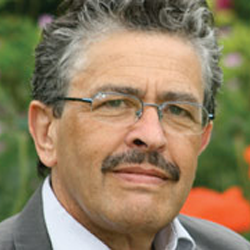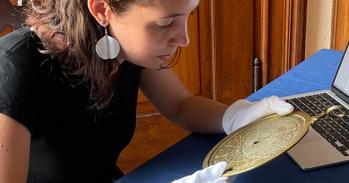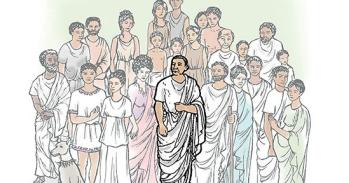
Researchers at the Faculty of Divinity are using ancient manuscript fragments to re-evaluate a forgotten episode of biblical history.
Researchers at the Faculty of Divinity are using ancient manuscript fragments to re-evaluate a forgotten episode of biblical history.
Since the 1970s, Professor de Lange has been collecting and studying evidence for the use of Greek Bible translations by Jews in the Middle Ages.
One of the greatest and most lasting achievements of Jewish civilisation in the Graeco-Roman period was the translation of the Hebrew scriptures into Greek between the 3rd and 1st centuries BCE. It was an unprecedented project: not only was it the first translation on such a scale, but it also opened up the core teachings of the Jewish religion to Jews who did not understand the sacred language, as well as to the non-Jewish world. Without this translation, it is doubtful whether Christianity could have spread as quickly and successfully as it did. The translated books – which came to be known collectively as the Septuagint, after the 70 Jewish scholars said to have translated them – became a keystone of teaching and worship for large numbers of Jews and Christians for centuries, and still constitute the Old Testament for Greek-speaking Christians today.
The study of the Christian history of these books has long been pursued in European universities. But the Jewish origin of the translations, although not entirely forgotten, has been sidelined, according to a general supposition that Jews gave up using the translations along with their use of the Greek language.
However, evidence has been unfolding to the contrary, aided by the discovery of long-lost manuscript fragments confirming that Greek Bible translations continued to be used in Byzantine Judaism. A project led by Nicholas de Lange, Professor of Hebrew and Jewish Studies in the Faculties of Divinity and Asian and Middle Eastern Studies, is spearheading this re-evaluation of a mysterious time in biblical history. It is also providing the latest instalment of a quintessentially Cambridge story.
Rediscovering Jewish tradition
In the 1890s, the University of Cambridge was the world centre of Septuagint scholarship. Cambridge academic Solomon Schechter had returned from Cairo with the largest and by far the most important hoard of Hebrew manuscripts ever discovered. One of the most exciting discoveries to emerge from a first trawl through the fragments was a palimpsest, a manuscript that had been reused for writing another text. The original writing was from a handsome Greek copy of the Books of Kings, not in the Septuagint translation but in a later translation made in the early 2nd century CE by a convert to Judaism named Akylas. This was the first evidence of the continuous transmission of Greek Bible translations; many others were to follow.
 Since the 1970s, Professor de Lange has been collecting and studying evidence for the use of Greek Bible translations by Jews in the Middle Ages. Over the past three years, these have been gathered into an online corpus that, for the first time, has made the texts and analysis of them available to other scholars.
Since the 1970s, Professor de Lange has been collecting and studying evidence for the use of Greek Bible translations by Jews in the Middle Ages. Over the past three years, these have been gathered into an online corpus that, for the first time, has made the texts and analysis of them available to other scholars.
With funding from the Arts and Humanities Research Council (AHRC), the corpus is being prepared with the help of Dr Cameron Boyd-Taylor and Dr Julia Krivoruchko in the Faculty, as well as the highly specialised IT expertise of the Centre for Computing in the Humanities at King’s College London. The fully searchable corpus permits comparison of each word with the Hebrew text, the Septuagint, and the fragments of Akylas’ and other Jewish translations from antiquity.
Lifting the shroud of mystery
The project will aid understanding of the Jewish tradition of Bible translation in Greek-speaking lands throughout the Middle Ages: who produced the translations, who used them, and for what purposes? How widespread was their use at different times? To what extent was it an oral rather than a written tradition? The project will offer us a rare glimpse of Byzantine Jewish life and culture, the cross-fertilisation between Jewish and Christian biblical scholars in the Middle Ages, and add to our understanding of the history of the Greek language at that time.
For more information, please contact the author Professor Nicholas de Lange (nrml1@cam.ac.uk; https://gbbj.org/) at the Faculty of Divinity.
Image: Genizah palimpsest with Hebrew (shown upside down) written over the top of a 6th-century copy of Akylas’ Greek translation (c. 125 CE) of the Books of Kings (shown the right way up); T-S 12.184r. Taylor-Schechter Genizah Research Unit, reproduced by permission of the Syndics of Cambridge University Library.
This work is licensed under a Creative Commons Licence. If you use this content on your site please link back to this page.





